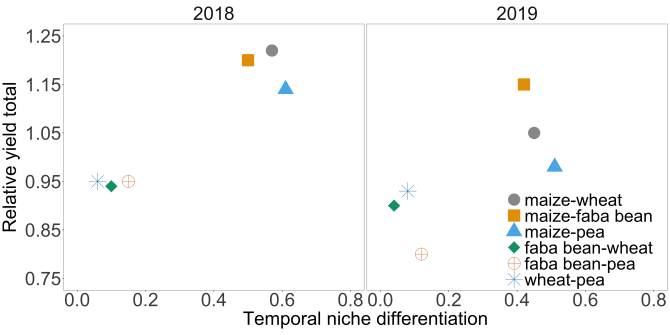
Project
Designing intercropping in the Western Europe
This project aims to investigate the plausibility of combining popular cereal and legume species as narrow strip intercrops to provide a sustainable intensification mode for conventional farming in Western Europe.
Background
Under organic agricultural conditions in Western Europe, intercropping has been studied with low resource inputs. However, little research has been conducted at conventional input levels. In this study, I evaluated the viability of six species combinations as narrow strip intercrops under conventional management conditions in the Netherlands.
Project description
Current agricultural systems should be improved by reducing inputs while maintaining or increasing yields, resulting in more efficient use of resources. Intercrops made of multiple species overlapping a portion of their growth cycles offer the chance to improve yields with decreased resource inputs.
While some species combinations have been studied with low resource inputs under Western-European organic farming conditions, few possible species combinations have been studied at conventional input levels. Therefore, there is a lack of knowledge regarding how intercropping systems should be developed for conventional growers in Western Europe. This raises the question of whether intercropping could be tailored to conventional production practices.
In this project, a two-year field experiment is conducted in the Netherlands. All six binary combinations of maize (Zea mays L.), wheat (Triticum aestivum L.), faba bean (Vicia faba L.), and pea (Pisum sativum L.) are investigated as narrow strip (1.5 m wide) intercrops for their productivity. Modeling and field obtained data are used to assess the light and nitrogen use efficiency of each species combination. The output of this project can help with species selection and configuration design of plausible intercrops in the future.
Results
Relay intercrops comprising a later sown maize and one of the other three species had relative yield total greater than one whereas simultaneously sown intercrops comprising two species other than maize had relative yield total close to one.

Publications
-
Strip intercropping of maize, wheat, pea and faba bean in the Netherlands
In: Intercropping for sustainability - Wellesbourne: Association of Applied Biologists - p. 221-224. -
Leaf functional traits in maize in intercropping
In: Intercropping for sustainability - Wellesbourne: Association of Applied Biologists - p. 393-396. -
Designing intercrops for high yield, yield stability and efficient use of resources: Are there principles?
Advances in Agronomy (2020), Volume: 160 - ISSN 0065-2113 - p. 1-50. -
Identification of species traits enhancing yield in wheat-faba bean intercropping: development and sensitivity analysis of a minimalist mixture model
Plant and Soil (2020), Volume: 455 - ISSN 0032-079X - p. 203-226.